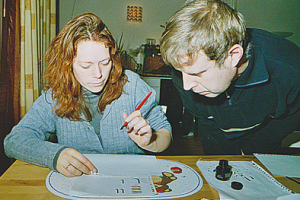
Photo credit: By Peter van der Sluijs under Creative Commons Attribution-Share Alike 3.0 Unported License.
Brain lateralization defines whether you are right- or left-brain dominant. The language function is located in the left hemisphere of the brain, which controls the right side of the body. Although left-handers are not necessarily adept at languages, left-handers receive more bias, with several words related to being left-handed in different languages. But still, it is fun to explore the correlation with being left handed and languages and other brain functions.
Right-handed versus left-handed
While the human brain is divided into two lateral parts, the left and the right hemispheres, the two sides control different functions and thought processes. The right side of the brain controls the left hand. The right side is also responsible for emotion and perception, for art and music. The left side of the brain controls the right hand as well as science, math, logic, writing, language and speech.
In the manner of thinking, the left side of a person’s brain is organized rigidly and handles logic and language, in short, straight line thinking. The right side controls the big picture, the abstract notions, the appreciation of the arts, the emotions.
Preference versus function
The distinct functions of the left and right hemispheres of the human brain is what is typical. However, it does not mean that the location of the brain’s functions are that clearly indicated. It is a fact that about 95% of right-handed people’s language function is dominated by the left hemisphere of the brain, but there are almost 20% of left-handed people that have language functions from both sides of the brain while about 19% have language functions dominated by the right hemisphere.
The brain’s left hemisphere typically controls language functions such as literal meaning, vocabulary and grammar for about 90% of right-handers but it is more bilateral in about 50% of left-handed persons. In contrast, accentuation and intonation are controlled by the right hemisphere.
What is the point?
Humans show preference for one side of the body. They are either left-handed or right-handed. There are also some that are left or right footed. This preference is called laterality and like the propensity to use the left or the right, laterality also pertains to the primary use of the right or the left hemisphere of the brain, which affects language. Most humans are right-handed and are also right-sided, preferring to use the right ear or right foot, as well as the right eye. The closest explanation is that with the brain’s left hemisphere controlling the body’s right side, it is stronger whereas the left hemisphere is more dominant over the right hemisphere because nearly 92% of all humans use the left hemisphere for language.
Culturally-speaking, right handed people are very well accepted socially. If you look at it, the word “left” has different meanings that are a bit biased. Lyft is the origin of the word “left,” which actually means “useless” or “weak.” In French, left is “gauche” that means “tactless” or “awkward.” The Latin word “sinistra” that is the origin of the word “sinister” in English, also means left. In English though, there are very few words for “right” is “correct” and even its origin, the Anglo-Saxon word, “rith” also means “correct” or “straight.” And the bias for the left-handed is also true with other cultures, including the Chinese characters that were designed to be written by right-handers.
It is a good thing that today, society is not putting too much pressure on the left-handed¸ as the younger generation are not that conscious that there is societal bias for the left-handed.












Sorry, the comment form is closed at this time.